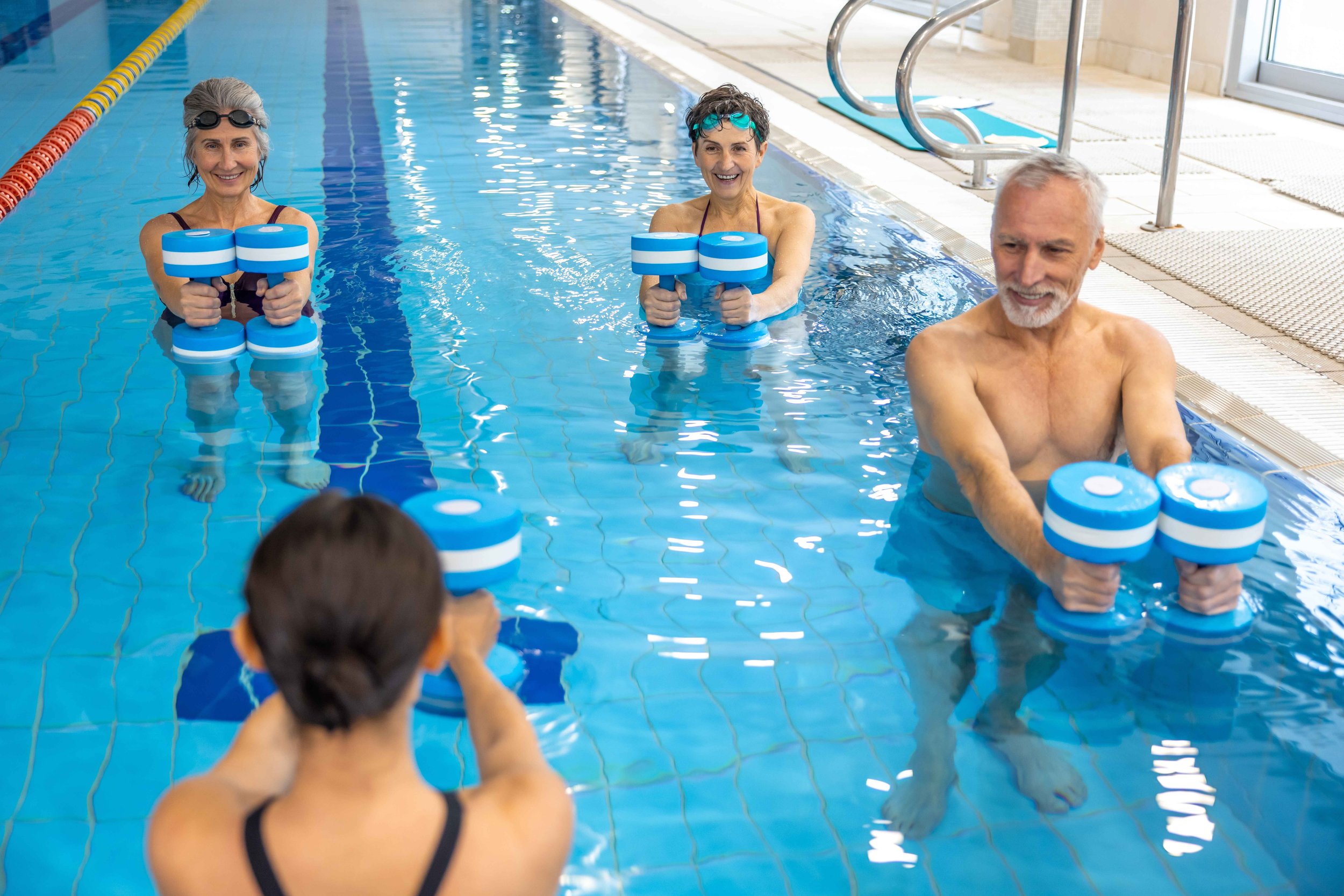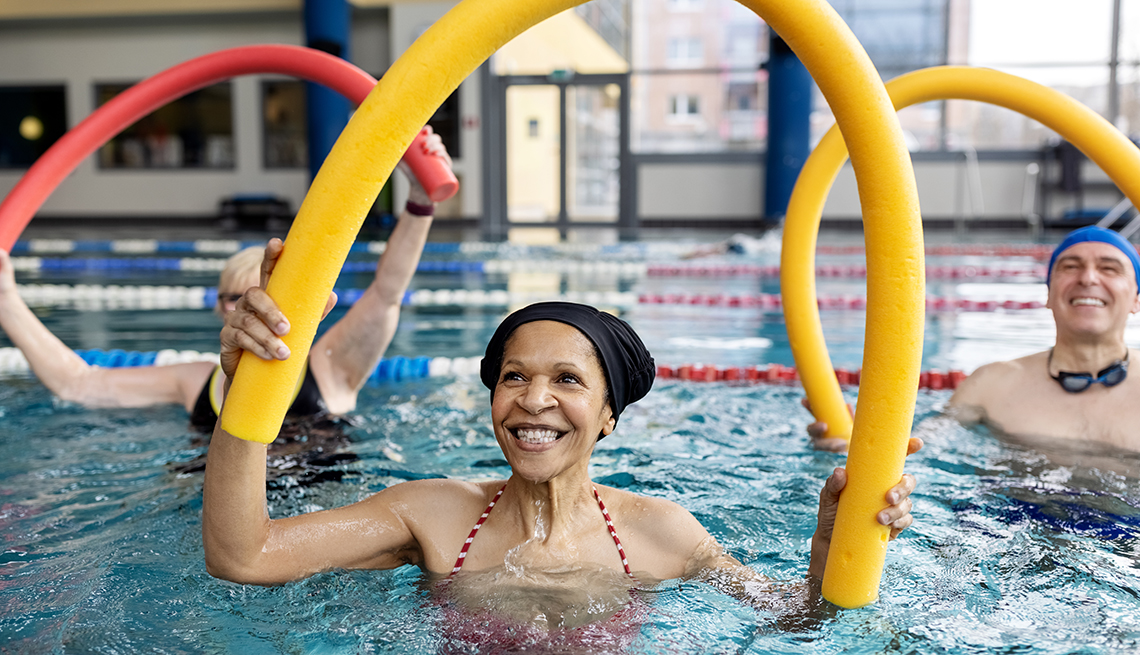Dive In and Trim Down: Unpacking the Calories Burned in Water Aerobics

Dive In and Trim Down: Unpacking the Calories Burned in Water Aerobics
Water aerobics has surged in popularity as a fun, low-impact way to get fit.
Combining the buoyancy of water with rhythmic movements, it offers a refreshing alternative to traditional land-based exercises.
But one of the most common questions for those considering taking the plunge is: just how many calories does water aerobics burn?
Let’s dive deep into this question and explore the factors that influence the caloric expenditure of this aquatic workout.
How many calories does 1 hour of water aerobics burn?

The number of calories burned in one hour of water aerobics can vary significantly based on several factors, but on average, you can expect to burn between 400 to 600 calories per hour.
Some sources suggest a range as wide as 450 to 700 calories.
This puts water aerobics in a similar calorie-burning range to activities like brisk walking, low-impact aerobics on land, and light swimming.
What factors affect calorie burn in water aerobics?
Several elements influence the number of calories you’ll expend during a water aerobics session. Understanding these factors can help you tailor your workout for optimal calorie burn:
- Intensity of the workout: Just like any other form of exercise, the harder you work in the water, the more calories you’ll burn. High-intensity water aerobics classes that incorporate larger movements, faster tempos, and resistance equipment will lead to greater caloric expenditure.
- Your body weight: Individuals who weigh more will generally burn more calories performing the same activity for the same duration as someone who weighs less. This is because it takes more energy to move a larger body mass.
- Your body composition: Muscle tissue burns more calories at rest than fat tissue. Therefore, individuals with a higher percentage of muscle mass may burn slightly more calories during water aerobics.
- Water resistance: Water is significantly denser than air, providing natural resistance to your movements. The more surface area you push against the water and the faster you move, the greater the resistance and the higher the calorie burn.
- Water temperature: While the effect is relatively minor, exercising in cooler water may cause your body to burn slightly more calories to maintain its core temperature.
- The specific exercises performed: Different water aerobics exercises engage different muscle groups and require varying levels of effort. For example, deep-water running or using water dumbbells will likely burn more calories than simple arm movements.
- Your fitness level: Individuals who are new to exercise may find water aerobics more challenging initially and thus burn a significant number of calories. As your fitness level improves, your body may become more efficient, potentially leading to a slightly lower calorie burn for the same intensity.
Is water aerobics good for weight loss?

Yes, water aerobics can be an effective part of a weight loss plan.
While the calorie burn per hour is moderate compared to some high-impact land-based exercises, water aerobics offers several advantages that can contribute to weight management:
- Calorie expenditure: As discussed, you can burn a significant number of calories during a water aerobics session, contributing to a calorie deficit necessary for weight loss.
- Low impact: The buoyancy of water reduces the stress on your joints, making it an excellent option for individuals who may have difficulty with land-based exercises due to joint pain, injuries, or weight. This allows for longer and more frequent workouts without the same risk of discomfort or injury.
- Full-body workout: Water resistance engages multiple muscle groups simultaneously, leading to improved muscle tone and strength. Building muscle mass can also boost your metabolism, helping you burn more calories even at rest.
- Cardiovascular benefits: Water aerobics elevates your heart rate, improving cardiovascular health and endurance.
- Enjoyment and adherence: Many people find water aerobics enjoyable and refreshing, which can increase adherence to a regular exercise routine – a crucial factor for long-term weight loss success.
To maximize weight loss with water aerobics, it’s essential to combine it with a healthy and balanced diet.
Creating a consistent calorie deficit through both exercise and dietary changes is key to shedding pounds.
How does water aerobics compare to other exercises in terms of calorie burn?

Comparing water aerobics to other exercises in terms of calorie burn depends heavily on the specific activities and their intensity.
Here’s a general comparison for a 150-pound individual exercising for one hour:
- Water Aerobics: 400-600 calories (moderate to high intensity)
- Walking (3.5 mph): Approximately 314 calories
- Jogging (5 mph): Approximately 606 calories
- Swimming laps (moderate): Approximately 423 calories
- Cycling (leisurely, <10 mph): Approximately 292 calories
- Low-impact aerobics (land-based): Approximately 365 calories
- High-impact aerobics (land-based): Approximately 493 calories
As you can see, water aerobics can burn a comparable number of calories to moderate-intensity land-based exercises and swimming.
While high-impact activities like running may burn more calories per hour, water aerobics offers a gentler alternative with significant caloric expenditure.
[Image comparing different exercise activities in a visually appealing chart or infographic, highlighting water aerobics.]
Can you burn more calories doing water aerobics than swimming?
The number of calories burned in water aerobics versus swimming depends on several factors, including the intensity of both activities, the swimming stroke used, and individual characteristics like weight.
- Swimming: Calorie burn in swimming can vary widely based on the stroke and intensity. Leisurely swimming may burn fewer calories than vigorous water aerobics, while intense butterfly or freestyle swimming can burn significantly more – upwards of 700-900 calories per hour for a 150-pound person.
- Water Aerobics: As mentioned, the calorie burn typically ranges from 400 to 600 calories per hour. However, high-intensity water aerobics classes using equipment and dynamic movements can push this number higher.
In general, high-intensity swimming may have the potential to burn more calories than moderate-intensity water aerobics.
However, for individuals who find swimming challenging or prefer the structured format of an aerobics class, a vigorous water aerobics session can still provide a substantial calorie burn.
[Image showing someone doing a dynamic water aerobics movement next to someone swimming laps.]
What are some ways to increase calorie burn during water aerobics?
If your goal is to maximize calorie expenditure during water aerobics, here are some effective strategies:
- Increase the intensity: Incorporate larger and faster movements. Jump, kick, and use your full range of motion.
- Use resistance equipment: Water dumbbells, noodles, and webbed gloves can increase the resistance you work against, forcing your muscles to work harder and burn more calories.
- Work in deeper water: Exercising in chest-deep or deeper water requires more effort to maintain buoyancy and perform movements.
- Incorporate high-intensity intervals: Alternate short bursts of high-intensity exercises with brief recovery periods. This can significantly boost your calorie burn and improve cardiovascular fitness.
- Engage your core: Consciously engage your abdominal and back muscles throughout the workout to increase stability and work more muscle groups.
- Minimize rest periods: Keep the transitions between exercises short to maintain an elevated heart rate.
- Increase the duration: If you have the time and stamina, extending your water aerobics sessions will naturally lead to a higher total calorie burn.
- Try different classes and instructors: Some water aerobics classes are more intense than others. Experiment to find a class that challenges you.
[Image showcasing various pieces of water aerobics equipment like dumbbells, noodles, and webbed gloves.]
Are there any downsides to water aerobics in terms of calorie burn?
While water aerobics is a fantastic exercise option, it’s important to be aware of potential limitations regarding calorie burn:
- Perceived exertion: The cooling effect of water can sometimes make you feel like you’re not working as hard as you actually are. It’s crucial to focus on the intensity of your movements rather than just how you feel.
- Individual effort: The calorie burn is highly dependent on your effort level. If you’re not actively engaging your muscles and moving with purpose, you won’t burn as many calories.
- Less effective for pure strength building: While water resistance does build muscle endurance, it may not be as effective for building maximal strength compared to heavy weightlifting on land. However, this isn’t necessarily a downside for calorie burn.
- Accessibility: Access to a pool with suitable water aerobics classes may be a limitation for some individuals.
Despite these points, the benefits of water aerobics, including its low-impact nature and enjoyable format, often outweigh these potential drawbacks, especially for those seeking a sustainable and effective way to burn calories and improve overall fitness.
Conclusion: Making a Splash with Your Fitness Goals
Water aerobics offers a refreshing and effective way to burn calories, improve cardiovascular health, and build muscle endurance with minimal impact on your joints.
While the exact number of calories burned varies depending on individual factors and workout intensity, you ca
n generally expect to expend a significant amount of energy during a one-hour session.
By understanding the factors that influence calorie burn and incorporating strategies to increase intensity, you can maximize the benefits of this aquatic workout and make a real splash in achieving your fitness and weight loss goals.
So, grab your swimsuit and dive into a fun and calorie-burning water aerobics routine!
